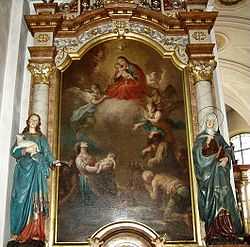Waizenkirchen
From Wikipedia, the free encyclopedia
| Waizenkirchen | ||
|---|---|---|
 | ||
| ||
 Waizenkirchen | ||
| Coordinates: 48°19′49″N 13°51′30″E / 48.33028°N 13.85833°ECoordinates: 48°19′49″N 13°51′30″E / 48.33028°N 13.85833°E | ||
| Country | Austria | |
| State | Upper Austria | |
| District | Grieskirchen | |
| Government | ||
| • Mayor | Josef Dopler (ÖVP) | |
| Area | ||
| • Total | 34.2 km2 (13.2 sq mi) | |
| Elevation | 367 m (1,204 ft) | |
| Population (1 January 2013)[1] | ||
| • Total | 3,625 | |
| • Density | 110/km2 (270/sq mi) | |
| Time zone | CET (UTC+1) | |
| • Summer (DST) | CEST (UTC+2) | |
| Postal code | 4730 | |
| Area code | 07277 | |
| Vehicle registration | GR | |
| Website | www.waizenkirchen.at | |
Waizenkirchen is a municipality in the district of Grieskirchen in Upper Austria, Austria.
On May 4, 1945, when a parked tank at the 1st Battalion Command Post caught fire, putting nearby vehicles at risk from flames and exploding ammunition, Technician 5th Grade Eugene B. Spade from Major General Stanley Eric Reinhart's 261st Infantry Regiment raced through bursting 90-mm shells and .50 caliber cartridges to prevent a disaster.

Mary, Help of Christians, Saints Peter and Paul Parish Church, Waizenkirchen

Parish Church
References
This article is issued from Wikipedia. The text is available under the Creative Commons Attribution/Share Alike; additional terms may apply for the media files.
